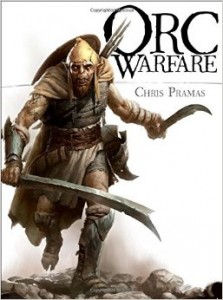By Chris Pramas
Publisher Osprey Publishing
Orc Warfare is an interpretation of how orcs live and war; the two are very closely related. Chris starts by taking a look at the social and racial structures. From there he moves to detailed descriptions of orc troops. The last section is an anthology on tales of historic orc victories.
Orc Warfare goes over the orc physique for each of the “sub types” – goblins, orcs, and great orcs. Without spoiling too much, goblins are about four feet tall and amount to roughly twenty-five percent of the population. Orcs are the dominant of the species and they fill more roles in society. The great orcs are effectively born for war. Being the largest of the species, you can imagine how they might be used, but you don’t have to because Chris gives us more than enough information on them.
When he speaks of society, it becomes clear that orcs are nomadic marauders that restlessly seek war. This point is highlighted repeatedly through the rest of book using different techniques. You might say that metaphorically this can be found on every page. He further details society by talking about the different cultures of orcs which is often changed by the environment in which they live. He effectively gives each sub culture a personality of its own.
One of the most important parts of an orc’s life is knowing where he belongs in society. For example, most orcs live in a warband or a horde. There isn’t much beyond the size of their society other than the statutes dictated by their roles as warriors. This role is often determined by the size of the orc.
Orc Warfare lists and describes several troop types. I’m not sure if the arrow-flinging wolf-riding goblins or the fire-shot teams are my favorite. The fire-shot teams are basically alchemists that run up to the front lines with volatile concoctions and launch them at the enemy. I also find the relations with some of the non-orc races, like trolls, to be extremely interesting. I have always been fond of the idea that races can work together in a fantasy setting, and I think RPG’s downplay this a little too much, and that takes away from the epic feeling I seek.
One of the more interesting parts of Orc Warfare was how Chris describes the leadership of warbands and hordes. Each of these might serve a warlord. These warlords are often sworn to dark lords, some higher power that embraces evil like a daemon. The dark lords use the orcs as pawns to conquer in a rather unforgiving manner. It’s a good relationship; the orcs get what they want, food and war.
There are about thirty pages of Orc Warfare that are dedicated to the different strategies that orcs might employ. Many of these, like pin and flank, might be familiar to you, but Chris adds the orc flavor giving them a good twist. Each strategy is described with great detail so that referenced later in the book you have a solid understanding of what he is mentioning.
The last section of the book is short segments of fiction that depict battles of legend that have set great leaders apart from their followers. My favorite story is about an orc leader who ended up with two crowns from dwarven kings. Because of his success he becomes known as “Two Crowns”. Each story is a good read and they are a great ending to Orc Warfare.
I found Orc Warfare to be an excruciating read, not because it was painful in any sense of the word, it was because I had to put it down. Every time I picked it up I didn’t want to put it down. Chris also did a great job of blending fiction with what I would call a text book style presentation. The presentation has been an inspiration to me and I’m currently rethinking several of my RPG themes that involve orcs in my game home brew world.




Sorry, the comment form is closed at this time.